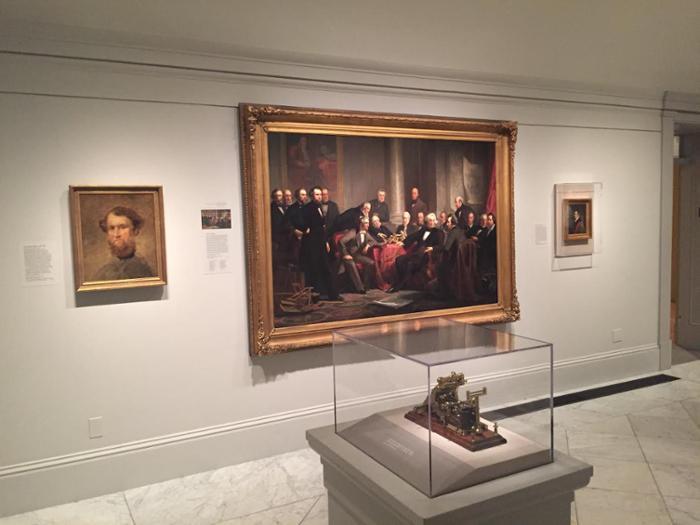Imagine a group portrait of the 21st century’s top living innovators. It might include Bill Gates, Jeff Bezos, Lori Greiner, Sheila Lirio Marcelo, Joy Mangano, Sheryl Sandberg and Mark Zuckerberg, among others.
The portrait could take the form of an Annie Liebowitz photograph and quickly go viral across social media platforms. It would be a testament to America’s technological prowess and perhaps inspire others in this golden age of innovation.
The concept wouldn’t be new.
Nearly 160 years ago, a plan to honor those who exemplified American innovation was behind “Men of Progress,” one of the most enduring portraits of the 19th century. Begun by French artist Christian Schussele in 1857 and completed five years later, the portrait depicts the founding fathers of American invention.
Union’s longtime president, Eliphalet Nott, is featured prominently in the painting. An expert in the physics of heat (he became popularly known as “Philosopher of Caloric”), Nott solved, through 20 years of experimentation at the College beginning in 1812, the problem of how to efficiently use the cleaner, hotter, longer-burning anthracite coal in stoves.
“Nott stoves” became so popular they were referred to in literary works by Cooper and Holmes, and the fact that Union was headed by a man of incontrovertible practicality long helped swell the enrollments of an institution committed to both classical and practical education.
Nott is positioned in the center of the portrait, surrounded by an impressive group of industrialists, inventors and innovators. Some are familiar, such as Charles Goodyear (vulcanized rubber), Samuel Morse (telegraph) and Samuel Colt (revolver). Others are more obscure, like Cyrus Hall McCormick (mechanical reaper), Elias Howe (sewing machine) and dentist William Morton (anesthesia).
The group originally included 18 living subjects. But John Ericsson (ironclad ships) was added at the last minute when the U.S.S. Monitor defeated the Confederate States’ Merrimack during the Civil War.
Standing watch over this group of game changers is a painting of Benjamin Franklin, arguably America’s greatest inventor.
While others acknowledge the glaring omission of women, the portrait is meant to represent the ambition, promise and achievements of a young nation at a crossroads.
“All honor to them – the inventors – for to them we owe the mighty triumphs of modern civilization; and the debt of gratitude due them is all the more, that theirs has been a path strewn with many thorns and few flowers…” reads the key to the engraving of the painting written by artist, architect and engineer John Skirving, the creative force behind the project.
The 4-foot-by-6-foot painting hangs on the first floor of the National Portrait Gallery in Washington, D.C. in the permanent collections galleries devoted to 18th and 19th century history.
So how did “Men of Progress” come to canvas?
Skirving wanted to celebrate inventors and the idea of progress so prevalent in mid-19th century America. He asked his friend, Jordon L. Mott, a wealthy New York patron of the arts, to bankroll the project and oversee its direction. Mott, owner of the very successful J.L. Mott Iron Works, had produced the first anthracite cooking stove. He included himself in the portrait.
Familiar with Schussele’s work, Mott commissioned the artist for the portrait. Remarkably, the subjects did not assemble as a group for the painting.
“The picture does not represent any event or actual gathering of the distinguished men whose portraits appear,” Skirving explained in his key. “This form of a convention, or conversazione, has been assumed only as a means of presenting in a natural and picturesque manner so many likenesses together, and as free as possible from formality and stiffness.”
The process Schussele followed to create the portrait is unclear. One theory is that the artist visited with each subject. Most historical accounts cite this process, which has been repeated often over the decades, including major features in The New York Times in 1962, The American Scientist in 1994 and the Wall Street Journal in 2015.
Historian David Rotenstein has done extensive research on Skirving and the painting. He believes Skirving persuaded most of the subjects to come to Schussele’s studio in Philadelphia for a sitting. He bases this, in part, on letters he discovered from Skirving to Morse and Colt in which he describes the arrangements for the painting.
Wayne Somers ‘61, author of the Encyclopedia of Union College History, says it’s likely both theories are accurate; some subjects went to Philadelphia, while Schussele visited with those who couldn’t or wouldn’t travel.
In the case of Nott, who is depicted in a bust-length view, no evidence has emerged to explain how he was sketched. An extensive review of Special Collections failed to uncover any correspondence between Union’s fourth president and any of the principal players behind “Men of Progress.” A visit to the archives of the National Portrait Gallery also did not yield any documents to bolster either theory.
However, during the period Schussele worked on the painting, Nott was in poor health, making it unlikely he would have been able to make the trip from Schenectady to Philadelphia. He died in 1866, four years after the painting’s completion.
More than a century later, the painting continues to inspire generations of people.
After Carl George, professor emeritus of biology, visited the National Portrait Gallery years ago, he spearheaded an effort to make copies of the painting for campus use. A print still hangs in the Becker Career Center and Steinmetz Hall.
“Today, when we are thinking hard about where technology is taking us, it is fascinating to look at the beginnings of some of those technologies and their inventors,” said Brandon Fortune, chief curator of the National Portrait Gallery. ‘Men of Progress’ has special resonance as it is shown in the National Portrait Gallery; the museum is situated in the Old Patent Office building, where inventions were registered and shown for many decades.”
To learn more, visit the National Portrait Gallery.
